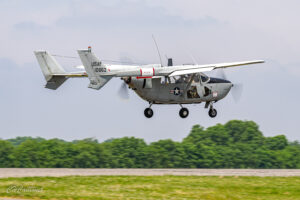Project Description

MPH
WEAPONS
SEATS
Cessna O-2 Skymaster
Role: Observation aircraft
National Origin: United States
Manufacturer: Cessna
First Flight: 1967
Primary User: US Air Force, Botswana Air Force, Salvadorian Air Force
Number Built: 532
As with the civilian version, the Skymaster was a low-cost twin-engine piston-powered aircraft, with one engine in the nose of the aircraft and a second engine in the rear of the fuselage. The push-pull configuration meant a simpler single-engine operating procedure due to centerline thrust compared to the common low-wing mounting of most twin engine light planes, and also allowed for a high wing, providing clear observation below and behind the aircraft.
Modifications made for the military configuration included installation of single seating fore and aft (i.e. two tandem seats available for pilot and observer, vs. 6 seats available in the civilian version); installation of view panels in the doors (for improved ground observation); installation of flame-retardant foam in the wing-mounted fuel tanks (slight increase in empty vehicle weight; 3% reduction in available fuel capacity); installation of military communication and navigation equipment in lieu of available civilian equipment and antennas; deletion of propeller spinners; increased gross weight (5,400 lb vs. 4,400 lb in civilian version), with component strengthening as required to support the increase; and deletion of interior upholstery.
The first O-2 flew in January 1967 and the plane went into production shortly thereafter. Performance (especially at cruising altitudes) was degraded due to the added antennas and significant weight increase, but was considered sufficient for the anticipated low-level operation.
The Cessna O-2 Skymaster (nicknamed “Oscar Deuce”) is a military version of the Cessna 337 Super Skymaster, used for forward air control (FAC) and psychological operations (PSYOPS) by the US military between 1967 and 2010.
In 1966 the United States Air Force (USAF) commissioned Cessna to build a military variant to replace the O-1 Bird Dog and the O-2 resulted.
General characteristics
- Crew: 2 – Pilot and Observer
- Length: 29.75 ft (9.07 m)
- Wingspan: 38.17 ft (11.63 m)
- Height: 9.17 ft (2.79 m)
- Wing area: 202.5 ft² (18.81 m²)
- Empty weight: 2,848 lb (1,292 kg)
- Loaded weight: 5,400 lb (2,449 kg)
- Powerplant: 2 × Continental IO-360C six-cylinder flat engines, 210 hp (157 kW) each
Performance
- Maximum speed: 200 mph (322 km/h)
- Range: 1,325 mi (2,132 km) combat
- Service ceiling: 18,000 ft (5,490 m)
- Wing loading: 26.67 lb/ft² (130.2 kg/m²)
- Power/mass: 12.86 lb/hp (7.82 kg/kw)